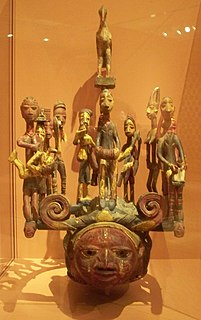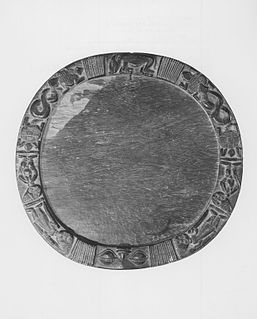 W
WThe Yoruba of West Africa are responsible for one of the finest artistic traditions in Africa, a tradition that remains vital and influential today.
 W
WAdire textile is the indigo-dyed cloth made in southwestern Nigeria by Yoruba women, using a variety of resist-dyeing techniques.
 W
WAgere ifa is a holding receptacle, vessel or container for keeping and raising the sacred palm nuts or ikin used in Yoruba divination. Most Agere are made from a medium of wood, but also ivory and coconut shells.
 W
WThe Apapa Hoard is an important collection of medieval bronze jewellery found at Apapa near Lagos, Nigeria. Dating to the early 16th Century, the hoard has been part of the British Museum's collection since 1930.
 W
WAse or ashe is a Yoruba philosophical concept through which the Yoruba of Nigeria conceive the power to make things happen and produce change. It is given by Olodumare to everything — gods, ancestors, spirits, humans, animals, plants, rocks, rivers, and voiced words such as songs, prayers, praises, curses, or even everyday conversation. Existence, according to Yoruba thought, is dependent upon it.
 W
WAso oke fabric, is a hand-woven cloth created by the Yoruba people of west Africa. Aso oke means "top cloth" in the English language, denoting cloth of high status. Usually woven by men and women, the fabric is used to make men's gowns, called agbada and hats, called fila, as well as women's wrappers, called iro and head tie, called gele.
 W
WAn Epa mask is a ceremonial mask worn by the Yoruba people of Nigeria during the Epa masquerade. Carvings representing priests, hunters, farmers, kings, and mothers are usually depicted on the masks. They are used to acknowledge important roles within the community, and to honor those who perform the roles, as well as ancestors who performed those roles in the past.
 W
WAn aso oke hat is a soft hat traditionally worn by the Yoruba people of Western Africa. It is made of hand woven aso oke fabric, cotton, velvet, or damask. They are usually lined with cotton, but can be unlined if crafted to be worn for a single event.
 W
WThe Gẹlẹdẹ spectacle of the Yoruba is a public display by colorful masks which combines art and ritual dance to amuse, educate and inspire worship. Gelede celebrates “Mothers”, a group that includes female ancestors and deities as well as the elderly women of the community, and the power and spiritual capacity these women have in society. Focusing not only on fertility and motherhood but also on correct social behavior within the Yoruba society.
 W
WHealing of Abiku Children is a piece created by the Nigerian artist Twins Seven-Seven in 1973, located in the Indianapolis Museum of Art, which is in Indianapolis, Indiana, United States of America. It consists of a large wooden plaque intricately carved and dyed with pigment to depict an important Yoruba ceremony. In it, a mother consults with a priest to keep her abiku twins in this world, rather than dying and being reborn to her over and over.
 W
WThe Bronze Head from Ife, or Ife Head, is one of eighteen copper alloy sculptures that were unearthed in 1938 at Ife in Nigeria, the religious and former royal centre of the Yoruba people. It is believed to represent a king. It was probably made in the fourteenth-fifteenth century C.E.. The realism and sophisticated craftsmanship of the objects challenged Western conceptions of African art. The naturalistic features of the Ife heads are unique and the stylistic similarities of these works "suggest that they were made by an individual artist or in a single workshop."
 W
WThis Magbo helmet mask for an Oro society member was created by Yoruba artist Onabanjo of Itu Meko. It is currently located in the African collection of the Indianapolis Museum of Art, which is in Indianapolis, Indiana. Created around 1880-1910, it depicts a varied cast of community members carved of wood, colored with pigment, and mounted on a curved bar surmounting the helmet.
 W
WAn Oba's crown represents the highest level of authority vested in Yoruba rulers. Referred to as an ade, the bead-embroidered crown is the foremost attribute of the ruler. An oba's crown may also be referred to as an adenla, or great crown. Andenlas are elaborate conical headdresses, like the ade, but feature a heavily beaded veil that covers the face. In his article on the topic, Robert F. Thompson writes, "The crown incarnates the intuition of royal ancestral force, the revelation of great moral insight in the person of the king, and the glitter of aesthetic experience."
 W
WAn ọpọ́n Ifá is a divination tray used in traditional African and Afro-American religions, notably in the system known as Ifá and in Yoruba tradition more broadly. The etymology of opon, literally meaning "to flatter", explains the artistic and embellished nature of the trays, as they are meant to praise and acknowledge the noble work of the Babalawo (diviners). The etymology of the term Ifá, however, has been a subject of debate. Ifá may be considered an orisha, or a Yoruba god — specifically, the god of divination Orula. Conversely, some scholars have referred to Ifá merely as the "great consulting oracle" as opposed to a god or a deity, without any divine connotations.
 W
WYoruba herbalists and priests enlist the aid of Osanyin, the spirit of herbal medicines, or Opa Erinle, in their work against mental and physical illness caused by malevolent forces and individuals. The Yoruba believe the power of Osanyin is vested in a wrought iron staff, called an Osanyin staff, that is placed on altars to this Orisha.